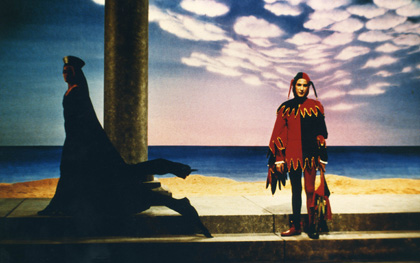Primary navigation


Director Eugène Green sings the praises of Portugal’s José Alvaro Morais and his 1987 masterpiece O Bobo
The Portuguese film-maker José Alvaro Morais (1945-2004) is little known outside his native country. Trained as a director at the ENSAS school in Brussels, he made his first feature in 1976: Ma femme chamado Bicho (My Wife Named Bug), a documentary about the artist couple Maria Elena Vieira da Silva and Arpad Szenes. Morais’ first fiction film was O Bobo (The Jester), which he began making at the end of the 1970s. Production was interrupted several times for lack of funding, and the film didn’t see the light of day until the 1987 Locarno Film Festival, where it won the Golden Leopard. He finished the experimental long-short Zéfiro (Zephyr) in 1994, and finally in 2000 a new fiction feature was released, Peixe lua (Moonfish). His last feature, Quaresma (Lent) was presented in 2003 in Directors’ Fortnight in Cannes. Yet just as Morais was beginning to achieve international recognition, his untimely death put an end to his career. All his films show the qualities of an original and demanding artist, but O Bobo, though a ‘difficult’ film, is by far the richest and most nearly perfect.
The ‘difficulty’ of this film lies not only in the cinematographic language used (which is also one of its main strengths), but also in the extremely complex subject-matter. The narrative framework is the ‘white night’ spent in Lisbon by Francisco (Fernando Heitor) and his girlfriend Rita in 1978, at the end of a day in which João, Francisco’s childhood friend, is murdered. During the dictatorship João belonged to a subversive leftist group, but just four years after the revolution he has lost all his ideals and is seeking to sell arms to mysterious fascist clients. This complex story, with its many ramifications, is blended with the rehearsals of a play Francisco is directing and playing the title role in: O Bobo, adapted from a 19th-century historical novel by Alexandre Herculano, and relating the accession of Dom Afonso Henriques, the first king of Portugal.
The scenes from the play make up an important part of the film, but they are not just an accessory element. In a subtle way, the director creates connections between the ‘real’ story and the fictive one, with the emotions produced by both entering a common stream. The three main characters dream of leaving Portugal, which seems to them a narrow cage, but they are caught up in the destiny of their country, the origin of which is precisely the historical moment depicted in the play.
The parallels also point up the ambiguity of the ‘real’ characters. It seems to Francisco that he endures his life passively, but in the play he has the role of the Jester, who determines all the action. Rita considers João to be a traitor, while in the play D. Teresa – who refuses to give up power to her son, the rightful heir – might also be considered one. But D. Teresa renders her behaviour – and perhaps that of João too – more mysterious when she confesses to the Jester that she believes in the destiny of Dom Afonso Henriques, but wants him to win power through battle in order to be respected by the people.
In the same way the death of the ambiguous stage heroine Dulce – saint or traitor? – takes place simultaneously with the murder, in the wings, of João, whose moral character also remains mysterious. Francisco takes up this metaphysical relationship between fiction and reality (which constitutes a great part of Portuguese identity) when he says, in a sentence which would not be disavowed by the great Portuguese poet Fernando Pessoa, “Lisbon exists because we invent it.”
Morais’ personal cinematographic language, which he would continue to use in his succeeding films, corresponds perfectly with these themes. The most striking aspect is a narrative construction which, through very subtle editing, makes the viewer slide from past to present, from fiction to reality, transforming them into one unique sphere of existence. This creates an impression of incessant movement, even when, as is often the case, the shot retains the original frame. A notable exception is in the play sequences, where there is a great deal of camera movement, but this is a counterpoint to the static condition of dramatic art – and a means of turning the theatrical scenes into cinema.
One of the most striking camera movements takes us from the stage – where Dulce is rehearsing – to the wings, where a police inspector calls out Francisco for a tense conversation, while the sound of the rehearsal continues. Morais is capable of composing shots of a great plastic beauty, but the aesthetic quality always serves the expression of an emotion or an idea, as in the repetitive image of train wheels rolling along the coast between Estóril and Lisbon, or the final camera movement which takes us from the church square at dawn, where Franciso and Rita have ended up with a group of drunken sailors, to the gateway beyond which we glimpse the river Tagus and the bridge.
The works of José Alvaro Morais represent the formal experimentation and the belief in film as an independent art that were characteristic of European cinema in the 1960s and 1970s. In a certain sense, this is true of Portuguese cinema up until the present. With its complex language, its exploration of history and cultural identity, and its play on the ambiguity of time and reality, O Bobo has its place in a list of great Portuguese films including Um adeus português (A Portuguese Goodbye, 1986) by João Botelho, Nao (Non, 1990) by Manoel de Oliveira and the recent Aquele Querido Mês de Agosto (Our Beloved Month of August) by Miguel Gomes, all of which must also be counted among the major films of world cinema.
Eugène Green is the director of The Living World and The Portuguese Nun
“The film presupposes a knowledge of Portuguese culture and recent history… but though I occasionally found myself at sea in following all the significations, the beauty of the mise en scene and Mário de Carvalho’s photography, and the grace with which Morais negotiates between different time frames and modes of narration kept me entranced. Combining the meditative offscreen dialogue of a film like India Song with the use of a historical play to investigate national identity (as in Raúl Ruiz’s Life Is a Dream), [O Bobo] offers a complex, multilayered view of revolutionary retrenchment that is worthy of standing alongside some of the best films of Manoel de Oliveira.”
— Jonathan Rosenbaum, Chicago Reader, 21 July 1989
The Portuguese Nun reviewed by Peter Matthews (February 2011)
IndieLisboa 2010: Mar Diestro-Dópido on a festival brimming with young international talent (May 2010)
Our Beloved Month of August reviewed by Jonathan Romney (February 2010)
Crossing the threshold: Kieron Corless interviews Pedro Costa (October 2009)
Serenity: Miguel Gomes on Pedro Costa’s collaboration with the inhabitants of Fontainhas on the margins of Lisbon (October 2009)
Game for a century: Jonathan Romney on Manoel de Oliveira (December 2008)
Cannes 2006: unpopular culture: Jonathan Romney on Eugène Green’s short ‘Les Signes’ (July 2006)
Mal reviewed by Philip Kemp (July 2000)